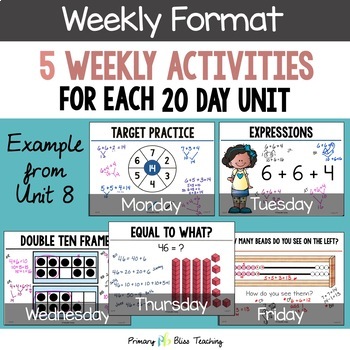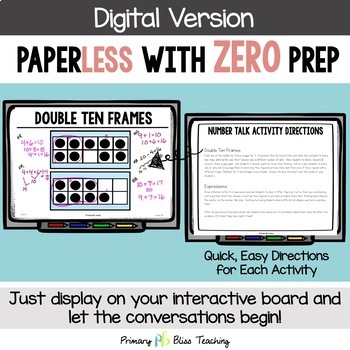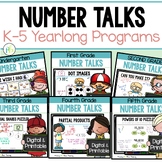FIRST GRADE NUMBER TALKS BUNDLE for BUILDING NUMBER SENSE AND MENTAL MATH
- Zip
- Google Apps™

What educators are saying
Products in this Bundle (10)
showing 1-5 of 10 products
Bonus
Also included in
- MATH TALKS are hands-down the BEST math warm-up activities out there for developing NUMBER SENSE and COMPUTATIONAL FLUENCY. And these PAPERLESS Number Talks for grades K-5 make implementing Number Talks EASIER than ever. This seriously NO PREP resource provides DAILY lessons that are thought-provokiPrice $168.00Original Price $304.00Save $136.00
Description
Math Talks are hands-down the best math warm-up activities for developing number sense and computational fluency. And these Number Talks for first grade make implementing Number Talks easier than ever.
This seriously NO PREP resource provides daily lessons that are thought-provoking and engaging for every day of the year.
Talk about stress-free planning and teaching!
THESE UNITS CAN BE USED ON INTERACTIVE WHITEBOARDS, ARE COMPATIBLE WITH GOOGLE SLIDES, OR CAN BE PRINTED OUT. ALL THREE VERSIONS ARE INCLUDED.
This standards-aligned first-grade number talks resource is a must-have for any teacher wanting their students' computational strategies and mathematical reasoning abilities to soar to new heights.
You will be so excited to watch as your students' mental math abilities develop and grow to be stronger than ever.
Just display these number talks on your interactive whiteboard and get ready for amazing math conversations to begin.
Talk about a time saver and getting the biggest bang for your buck!
Our number talks are extremely EASY TO USE and will save you TONS of TIME.
There are 5 activities each week that the students repeat over a 4-week time frame. This makes life oh so easy for teachers, and gives students repeated opportunities to engage in each particular number talk activity.
Our students LOVE this daily routine! We just know yours will too!
==============================================================================
WHAT'S INCLUDED IN THIS RESOURCE?
- 9 Units (180 Number Talk lessons in all):
Each unit contains 20 Number Talk lessons that address different Common Core Standards. The Number Talks get progressively more challenging as students develop their mathematical skills and understanding.
- Easy Differentiation: Several of the lessons contain more than one Number Talk option for easy-peasy differentiation.
- Variety of Number Talk Activities: The activities change from month to month so that students remain highly engaged. This resource contains 31 different types of Number Talks activities. Say "YES" to high engagement and "NO!" to boredom!
- Detailed Daily Lesson Plans: 180 detailed Number Talk lesson plans are included. We have spelled out how to deliver each Number Talk so you can teach with confidence starting on day one! These are GREAT for teachers new to number talks and substitute teachers.
==============================================================================
3 FREE BONUSES!:
- 7 Colorful Sentence Starter Posters to give your students confidence while sharing their thinking.
- 8 Silent Hand Signal Posters to increase student engagement as all students can communicate their thinking in a way that does not disrupt the learning environment.
- 12 Addition & Subtraction Strategy Posters for your students to refer to all year long... and, oh, such a cute addition to your classroom walls.
==============================================================================
TEACHERS LIKE YOU SAID:
⭐⭐⭐⭐⭐
“This has been the best thing I have EVER bought on TPT, hands down. This ensures my number talks are meaningful, interesting, and something that my kids look forward to each day.”
⭐⭐⭐⭐⭐
"Such a thorough and fantastic resource for Number Talks! Love it for my firsties! The creators are so amazing, they even made digital versions of ALL of their hard work and trust me, there's A LOT of content and time that went into this bundle! SO WORTH THE MONEY!"
⭐⭐⭐⭐⭐
“I wish more TPT products were as thorough as this! Each lesson is clearly laid out and easy to follow. A very valuable resource for number talks.” - Cynthia
⭐⭐⭐⭐⭐
“I know how much my students need number sense, and I know the power of number talks, BUT the daily planning was holding me back. These make it so so easy to implement number talks. My students enjoy participating in them, and we are off to a solid start! Love it!”
==============================================================================
WHY NUMBER TALKS?...
Number Talks will get your students engaged in mathematical conversations that will increase their ability to reason mathematically as well as develop their computational fluency skills and their ability to think flexibly about numbers.
But the BEST benefit is that it will turn your reluctant mathematicians into math lovers!
When students engage in this short daily activity, they communicate with their peers in a safe environment where it's okay to not be right all the time. It's okay to learn from each other.
They learn to discuss various strategies and the effectiveness of those strategies. They begin to take risks. And before you know it, your students who once feared math joyfully jump into solving problems with both feet.
It's so exciting to see the transformation!
==============================================================================
WHY DID WE CREATE THIS RESOURCE?
A few years ago we were asked to implement Number Talks in our daily math instruction. After engaging our students in a few of these activities, we were hooked. Our challenge then became to create a variety of problem types in order to keep students engaged and excited about Number Talks. And that is when this Number Talk resource was born.
==============================================================================
WHO IS THIS RESOURCE FOR? :
-Busy First Grade Teachers
-Substitute Teachers
-Special Education Teachers
-Whole Group Math Instruction
-Small-Group Math Instruction
-Math Intervention
==============================================================================
FAQ
How long do Number Talks take?
It is best if Number Talks are done daily for between 5 and 15 minutes.
Can these Number Talks be displayed on an interactive whiteboard?
YES! There's a fully digital version of our Number Talks using PowerPoint for your convenience! Just display and go! This makes implementing number talks easier than ever!
Does each month contain 20 different types of Number Talk activities?
Oh goodness no. That would be a bit overwhelming. We have 5 Number Talk activities that are repeated each week using different problems. We are all about keeping it easy for teachers and creating meaningful engagement for kids.
Do I have to print out Number Talk materials for each student each day?
NO! This is a whole group activity. Just display the number talk for everyone to see.
Do I need to teach the units in order?
We suggest you teach the Number Talks in order because they spiral and increase in difficulty.
Where are the daily lesson plans?
Daily lesson plans are in the printable version section. These are GREAT for teachers new to Number Talks as well as for substitute teachers.
I like my Number Talks to match the standards I'm currently working on, can I do this with this product?
This product was created as a spiral preview/review that gets progressively more challenging as you go through the units.
Do you have a resource that is organized standards?
Yes! First -Grade Number Talks by Standards
==============================================================================
COMMON CORE STANDARDS ADDRESSED in this RESOURCE
1.NBT.B.3 - Compare two two-digit numbers based on meanings of the tens and ones digits, recording the results of comparisons with the symbols >, =, and <.
1.NBT.C.4 - Add within 100, including adding a two-digit number and a one-digit number, and adding a two-digit number and a multiple of 10, using concrete models or drawings and strategies based on place value, properties of operations, and/or the relationship between addition and subtraction; relate the strategy to a written method and explain the reasoning used. Understand that in adding two-digit numbers, one adds tens and tens, ones and ones; and sometimes it is necessary to compose a ten.
1.NBT.C.5 - Given a two-digit number, mentally find 10 more or 10 less than the number, without having to count; explain the reasoning used.
1.NBT.C.6 - Subtract multiples of 10 in the range 10-90 from multiples of 10 in the range 10-90 (positive or zero differences), using concrete models or drawings and strategies based on place value, properties of operations, and/or the relationship between addition and subtraction; relate the strategy to a written method and explain the reasoning used.
1.OA.A.1 - Use addition and subtraction within 20 to solve word problems involving situations of adding to, taking from, putting together, taking apart, and comparing, with unknowns in all positions, e.g., by using objects, drawings, and equations with a symbol for the unknown number to represent the problem.
1.OA.B.3 - Apply properties of operations as strategies to add and subtract. Examples: If 8 + 3 = 11 is known, then 3 + 8 = 11 is also known. (Commutative property of addition.) To add 2 + 6 + 4, the second two numbers can be added to make a ten, so 2 + 6 + 4 = 2 + 10 = 12. (Associative property of addition.)
1.OA.B.4 - Understand subtraction as an unknown-addend problem. For example, subtract 10 - 8 by finding the number that makes 10 when added to 8.
1.OA.C.5 - Relate counting to addition and subtraction (e.g., by counting on 2 to add 2).
1.OA.C.6 - Add and subtract within 20, demonstrating fluency for addition and subtraction within 10. Use strategies such as counting on; making ten (e.g., 8 + 6 = 8 + 2 + 4 = 10 + 4 = 14); decomposing a number leading to a ten (e.g., 13 - 4 = 13 - 3 - 1 = 10 - 1 = 9); using the relationship between addition and subtraction (e.g., knowing that 8 + 4 = 12, one knows 12 - 8 = 4); and creating equivalent but easier or known sums (e.g., adding 6 + 7 by creating the known equivalent 6 + 6 + 1 = 12 + 1 = 13).
1.OA.D.7 - Understand the meaning of the equal sign, and determine if equations involving addition and subtraction are true or false. For example, which of the following equations are true and which are false? 6 = 6, 7 = 8 - 1, 5 + 2 = 2 + 5, 4 + 1 = 5 + 2.
1.OA.D.8 - Determine the unknown whole number in an addition or subtraction equation relating three whole numbers. For example, determine the unknown number that makes the equation true in each of the equations 8 + ? = 11, 5 = _ - 3, 6 + 6 = _.
Mathematical Practices
- Make sense of problems and persevere in solving them.
- Reason abstractly and quantitatively.
- Construct viable arguments and critique the reasoning of others.
- Attend to precision.
- Look for and make use of structure.
- Look for and express regularity in repeated reasoning.
==============================================================================
Click HERE to follow us and receive notifications for SALES, FABULOUS NEW RESOURCES, and FREEBIES!
========================================================================
FREE $$$ - LEAVE FEEDBACK on this product to earn TPT credits that can be used on future purchases!
==============================================================================
Having tech difficulties?
Please SUBMIT a help ticket, TpT has an AMAZING tech team.
==============================================================================
Copyright © Primary Bliss Teaching
Permission to copy for single classroom use only.
Please purchase additional licenses if you intend to share this product.
Cindy & Becky
Team Primary Bliss Teaching






